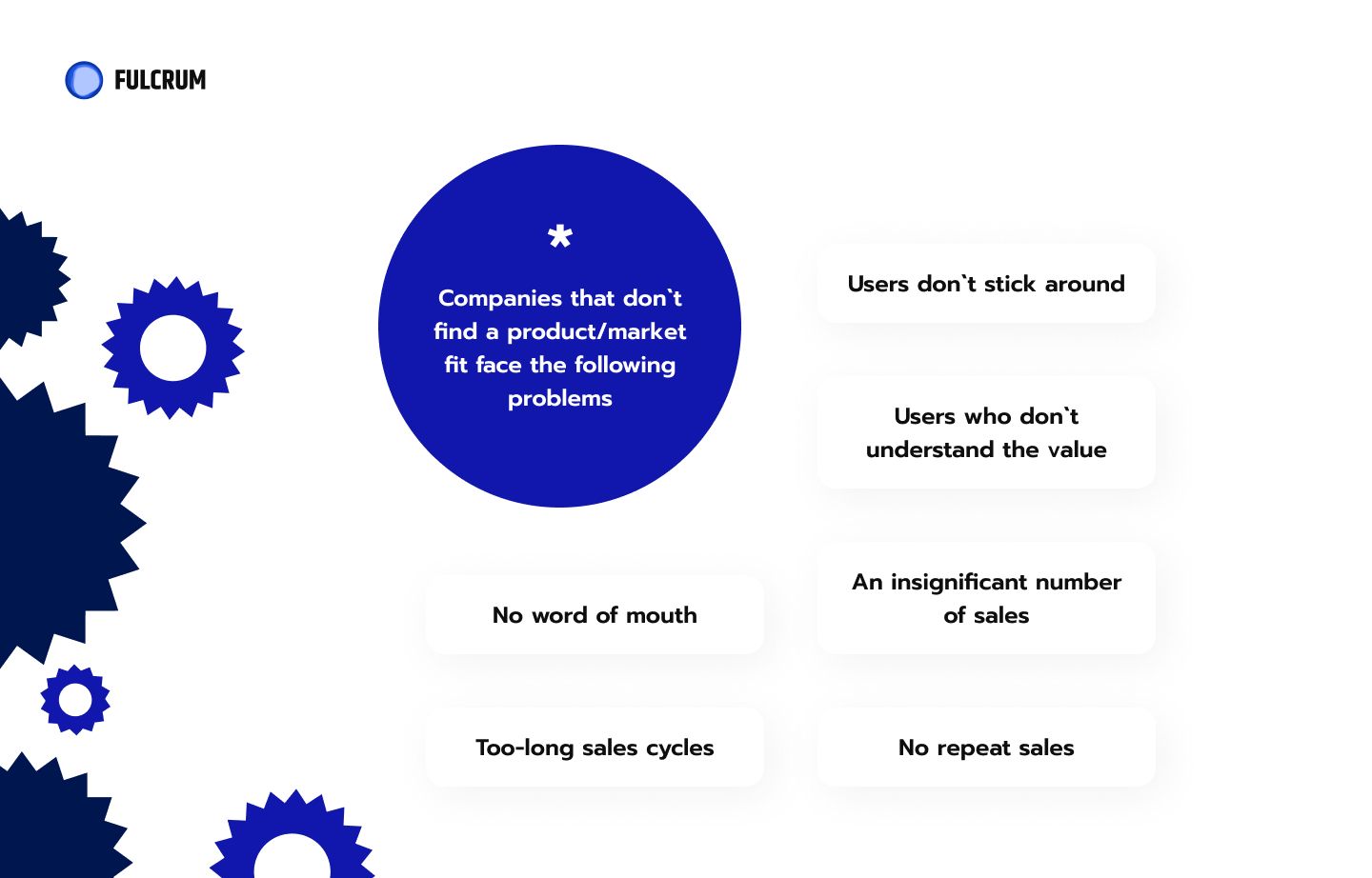It’s common knowledge – over 9 out of 10 startups fail. 34% of them fail because they lack product-market fit. Moreover, it is the number one reason for startups’ failure. So what is this magical thing that can destroy your product? Can you find it before launching the business? How do you do that?
We at Fulcrum want all our clients to be among the ones that succeed. This is why we make it a point to find product-market fit for every project we work on. Today we are going to answer your questions on product-market fit. Read on to find out what it is. And why it is crucial to find it before launching a new product. How to find and measure it. And how to make it work for you.
What is product-market fit
First, let’s define product-market fit. The concept is not very new. It was invented by venture capitalists and popularized in the startup field in the mid-2000s. Yet a precise definition of the term does not exist. There is a product-market fit definition in Wikipedia – “product-market fit, is the degree to which a product satisfies a strong market demand”. And other sources expand on it.
To put it simply, having product-market fit means you are in the right place at the right time. You provide the right product to the right people through the right channels.
But this is not a result of good luck. It is a result of meticulous research and planning. The decisions are always data-driven, never based on assumptions. Though a bit of luck is always a part of success.
Why should you care
If the numbers we shared at the beginning are not enough here’s a couple more things for you to consider.
A lot of startups are built on a brilliant idea and a big dream. Some of them manage to convince other people their brilliant idea is worth investing in. But without knowing if their product solves a real problem of a substantial number of people these startups are doomed. They spend all the investments on building something that is not commercially viable. A lot of them hire and scale prematurely. Eventually, they burn through the investments and fail.

Another thing is startups that don’t get much investments if any. These startuppers believe in their brilliant idea and dream that it will sell itself. Without any marketing budget ever being needed. Their product will go viral, the sales will skyrocket, and the startup will become a unicorn. History does know examples of this actually happening. But the truth is – they have the product-market fit behind the success.
When the customers find a product that solves a real pain for them they become the best salespeople. They recommend the product to other people. They share their excitement of finding it on social media. They leave rave reviews. The product “sells itself” without any marketing effort. And the startup becomes a unicorn.
How to find product-market fit
The process of finding product-market fit may vary from business to business. And it might look different for products that already exist as compared to the ones that are only an idea.
The basics are usually the same though. You need to have a deep understanding of your product, your customers, and your market. And you have to be ready to pivot if the situation demands it.
The process usually involves market research, user research, and competitors’ analysis. You need to formulate hypotheses. Validate them with research. Implement features or solutions based on the received data. Test the new implementations. Then you need to formulate new hypotheses, validate them, and implement new features. You get the drift. The tools, methods, and techniques of how to do all of that may vary.
In Fulcrum, we mostly work on new products. Clients come to us with an idea of a product. And we make finding the product-market fit for them a part of the development process. So here’s what we usually do to find a product-market fit for our clients.

Find the target audience and market
The questions we ask at this stage are:
- Who are our users?
- How do we find them?
- What are their needs and pains?
- What features do they want in an MVP (Minimum Viable Product)?
To answer these questions we conduct in-depth research of our client’s competitors and the market.
After we are done with the research we create a user persona. Here we include everything there is to know about our perfect user. How old they are, what they do for a living if they have a family, where they spend their free time, etc.
We create Jobs to Be Done for our perfect user. And Customer Journey Map for the main jobs to be done. These frameworks along with the research help us formulate hypotheses and come up with features that have to be included in our MVP.
The competitors’ research is a very important part of this stage. It does not only help us find our customers. It also helps us understand the market we are about to enter. Analyzing every competitor’s product helps us see their weaknesses and strengths. This in turn helps us uncover the opportunities to solve the problem differently.
💥 Discovery Phase of Software Development
Verify the hypotheses
The previous step was mainly built on assumptions. Now we need to verify if our assumptions are correct. Before spending the resources on building an MVP we need to make sure the problem our product is meant to be solving actually exists. And the users are willing to pay for the solution.
How do we do it? We talk to the customers. In-depth user interviews help us validate the hypotheses. And get invaluable insights we would never dream of getting without the interviews.
Build an MVP
When our initial hypotheses are verified we need to test them further to understand if we are on the right track. This is when the MVP comes into play.
Usually, the first MVP has a bare minimum of features. Only the ones that are absolutely necessary for the product to work. The key to success is to iterate fast and learn fast.
It’s great to deliver the very first MVP to the customers you talked to on the previous stage. Get feedback from them. Come up with new hypotheses to test. Update the MVP. And do it fast.
Test, observe and gather feedback
A/B tests are a great way to understand which things work best. And focus the resources on them for maximum efficiency. Some people A/B test everything, from the wording of their landing pages to the prices. We use this tool when there are doubts on which of the proposed solutions will work best. Or if an A/B test will help validate a hypothesis.
Asking for feedback from users is very useful. You can use surveys for that. But it’s not the only way to get feedback. We also implement metrics and observe the users’ behavior. Are they using the product as we intended it? Do they leave without completing the purchase? Do they leave on a specific step of the user flow? The point here is to know exactly what’s happening when the users use the product. When we have enough data we analyze it. The main question to ask at this point is – WHY is it happening? An objective answer to this question will show opportunities for growth. Or their lack.
How to measure it
Understanding you don’t have a product-market fit is pretty easy. Your product is not valued by the users. No one wants it. Knowing when you do have market fit is rather simple too. People gladly pay for your solution to their problem. And they keep paying for it every month. They love the product and share it with others.
But how do you know if you are on the right track when you are still on your way to achieving the market fit? The answer is – you need to measure your product-market fit. There are a number of ways to do it.
Sean Ellis test
This qualitative test provides a great metric to understand if you are on the right track. To get the metric you need to ask your users one simple question – How would you feel if you could no longer use our product? And ask them to choose one of these answers:
- very disappointed;
- somewhat disappointed;
- not disappointed.
If you get more than 40% of “Very disappointed” – congratulations, you are doing it right. Keep up the good work! Consequently, you have bad news if it’s lower than 40%.
According to Sean Ellis, you should ask these groups of users to take the survey:
- Users who experienced the core product
- Users who have experienced the product at least twice.
- Users who have experienced the product in the last two weeks.
Lifetime value to customer acquisition ratio (LTV/CAC)
This metric implies checking how much money you spend to acquire a paying customer versus how much you make from them. If what you make from a user is three times more than what you paid to acquire them then you are good. If the ratio is close to 1:1 you are spending too much. If it’s 5:1 you need to spend more.
Net promoter score
This metric allows you to see how likely your users are to recommend you to others. The data can be gathered from a short survey. You can ask your customers just one question. “On a scale of 0-10, how likely is it that you would recommend our product to your friends, family, or business associates?”
Users that give your product a 6 or below are Detractors. 7 or 8 are called Passives. And 9 or 10 are Promoters. To calculate your score you need to subtract the percentage of Detractors from that of Promoters. So if 50% of your respondents are Promoters and 10% are Detractors your score is 40.
Any Net promoter score above zero is considered a good sign. If you have more than 50 you have absolutely nothing to worry about.
What if the tests show you have no product-market fit?
Yes, getting bad news about your beloved product is disappointing. But it does not necessarily mean you have to close up and move on. Listen to what your customers have to say. Interpret the signals you receive from them. And see if you can find a way to adjust your product to fit their needs. Pivot!
Or better yet, come to Fulcrum for help. We’ll be happy to find product-market fit for your product!

FAQ: Product Market Fit
-
What is product market fit?A degree to which a product satisfies a market demand.
-
How to find product market fit?Research. Find the target audience and target market. Verify hypotheses and build an MVP. Test, observe, and gather feedback.
-
How to measure product market fit?Use the Sean Ellis test and gather other metrics.
-
What comes after product market fit?Hard work on not losing it.

